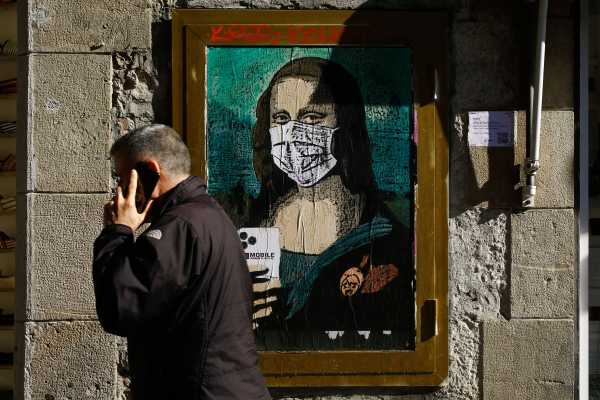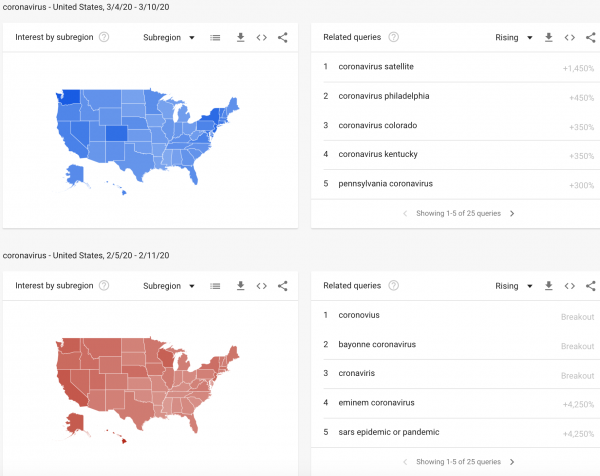
This story is part of a group of stories called

Uncovering and explaining how our digital world is changing — and changing us.
As the new coronavirus pandemic sweeps the globe and people take to their homes to avoid getting and spreading the contagion, it makes sense that much of the conversation about it is taking place online. People are using the internet to share information, air their anxieties, and bide time while in quarantine. The moments when those online conversations light up also tell us a lot about how our feelings around the pandemic are evolving.
Here’s what the online conversation about the coronavirus outbreak has looked like so far
Mentions of “coronavirus” across social platforms and news media really started to take off in late February, according to social media analytics platform Sprinklr. That was after the first coronavirus case of unknown origin, also known as community spread, emerged in the United States. That case involved a patient in California who contracted coronavirus but had neither traveled somewhere where the virus was present nor was knowingly exposed to someone with the virus. At around the same time, South Korean pop band and social media sensation BTS announced it was canceling tour stops due to the coronavirus and urged their fans to donate to relief efforts.
The latest spike in mentions shows how conversation around the coronavirus has exploded this week. Sprinklr counted a record nearly 20 million mentions of coronavirus-related terms on March 11. For context on just how big that number is, mentions of the newly canceled NBA games were under 2 million and mentions of Trump were about 4 million on that day.
The rise followed a number of big news stories concerning the coronavirus. This month saw huge government quarantines as well as instructions not to gather in large groups as the number of global infections blew past 100,000. Last night, President Trump declared a ban on most travel from most of Europe — with locations where he owns resorts being the notable exception. At the same time, the NBA suspended games after a player tested positive for Covid-19, the disease caused by the coronavirus, and Tom Hanks also announced he’d tested positive. The top-performing Facebook post for the last 24 hours is currently a post by Donald Trump about the coronavirus.
Sprinklr noted that the emoji most commonly associated with the coronavirus in the past month has been crying laughing, followed by crying loudly and a large red dot, used mainly in Latin America, Spain, and France to represent a warning. The medical face mask emoji was No. 5, after the hand pointing down.
“With 19 million mentions across social media and news sites related to Covid-19 in the past 24 hours alone around the world, it’s clear that coronavirus is the first global pandemic that is unfolding on social media with unprecedented volumes of conversations happening every second,” Grad Conn, Sprinklr chief experience and marketing officer, told Recode. “Global social media usage rates have grown by about 50 percent since 2014, when the Ebola epidemic was happening worldwide. And recent major news stories — including climate change, sporting, and political events — have not had the same global impact as coronavirus on individuals, businesses, and governments.”
Brandwatch, another social media analytics company, found that sentiment surrounding coronavirus posts is, unsurprisingly, mostly negative. The most prevalent emotion has been disgust, with many of those mentions centering around hand-washing and racism toward Chinese people. The second-most-common emotion in these posts was fear. In many cases, these mentions centered on specific locations, like Italy and Iran, where the ravages of coronavirus have been most acutely felt.
Note that while Sprinklr and Brandwatch have global data, it is more representative of Americans due to the platforms they survey and the keywords they use.
People’s concerns about coronavirus have also been evident in their search history. Google searches of coronavirus in the US saw their first major rise relative to all search traffic toward the end of January, after the first person in the US was diagnosed with the coronavirus after traveling abroad. In recent days, coronavirus has seen its highest level of search traffic — that level is indicated by a score of 100 on Google Trends:
This is huge search volume by any measure. Here’s that same trend indexed against perennially popular Google searches of “Trump,” “music,” and “video” for the last two months:
“I haven’t seen anything like this,” Simon Rogers, data editor on the News Lab team at Google, told Recode, referring to the rapid rise in coronavirus searches but warning that he could be missing something.
More heartening, though, Rogers said much of the Google searches center around a clear desire for useful information.
“People are not panic searching,” Rogers said. “People are looking for reliable info like, ‘How long should I wash my hands?’”
Meanwhile, Google and other online platform have been actively trying to root out misinformation about coronavirus. YouTube has been particularly hard hit with hoaxes suggesting ways to prevent the virus and ads seeking to capitalize on it, both of which the company has been working to block.
The conversation is also in flux. Here’s a comparison of Google’s US search traffic in the first week of March (top blue) versus the first week of February (bottom red). In February, accelerating search terms related to coronavirus included a couple of misspellings of the virus — which is what you’d expect when a keyword or topic is newly popular — as well as mentions of coronavirus in relation to SARS as people were initially trying to put the outbreak into historical context.

This month so far, most of the rising searches — an indication of what’s new on people’s minds — had to do with specific locations as people sought to track down the virus as it hit their backyards.
The top coronavirus-related search was for “coronavirus satellite,” in reference to a series of news stories, including one by the New York Times, that used satellite imagery to illustrate the drastic impact coronavirus quarantines have had on public spaces, with formerly crowded destinations apparently barren. The comparison also shows that celebrity news is always popular: Before there was a false coronavirus rumor about Daniel Radcliffe, there was one about Eminem.
As the number of coronavirus infections continues to grow, so will our need to talk about it on social media. This is only the beginning of a very long public conversation.
Sourse: vox.com





